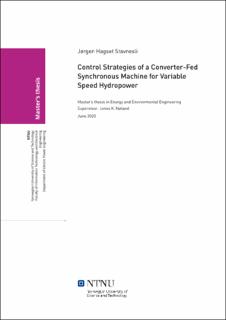| dc.contributor.advisor | Nøland, Jonas | |
| dc.contributor.advisor | Bergna-Diaz, Gilbert | |
| dc.contributor.author | Stavnesli, Jørgen Hagset | |
| dc.date.accessioned | 2021-09-15T17:16:14Z | |
| dc.date.available | 2021-09-15T17:16:14Z | |
| dc.date.issued | 2020 | |
| dc.identifier | no.ntnu:inspera:54192396:20998496 | |
| dc.identifier.uri | https://hdl.handle.net/11250/2778244 | |
| dc.description.abstract | Pumpekraftverk vert sett på som ei effektiv form for storskala energilagring, og har i long tid vore brukt for utjevning av forbruk og etterspørsel på dagsbasis. Framtidas kraftnett vil sjå eit auka behov for kontrollerbare kraftverk, som kan veie opp for innslag av fornybare energikilder prega av større varians i kraftproduksjon. Framsteg i kraftelektronikk har gjort det mogleg å installere frekvensomformera med ei merkeeffekt på opp mot 100 MVA til bruk for variabel turtallsdrift av pumpekraftverk. Ved å bruke ein frekvensomformar, så vert kraftverket uavhengig av nettfrekvensen, noke som gir potensiale for nye måtar å regulere drifta av kraftverket på.
Denne masteroppgava utforskar ulike kontrollaspekt ved omformer-mata synkronmaskinar, med eit fokus på magnetiseringssystemet og ulike forma for effektkontroll. Ein modell av ein omformer-mata synkronmaskin i eit pumpekraftverk vart modellert ved hjelp av simuleringsverktøyet Simulink, både for pumpe- og generator-drift. Ein flux-kontroller vart implementert for magnetiseringssystemet som gjorde at eit høgare moment-per-ampere vart oppnådd. Effektkontroll av pumpelasta, i form av "Load following"-kontroll og frekvenskontrollert last, vart òg undersøkt og viste seg å gi kraftverket ein auka eigenskap til å støtte det eksterne nettet. Til slutt så vart to typar "inertia"-kontrollarar implementert, og dei viste at systemet òg er i stand til å emulere treghet, noko som vart gjort ved å senke eller auke enten hastigheten eller dc-spenningen. For vidare arbeid med denne oppgaven så tilrådas det å byte ut 8 kVA maskina frå modellen med ein anna som ligger på omtrent 10-100 MW størrelse for meir realistiske simuleringar og test scenarioar. Ein anna ting vil være å sjå på "virtual synchronous machine"-kontroll av maskina i generator-drift. | |
| dc.description.abstract | Pumped-storage hydropower plants are seen as one of the best solutions for efficient, large-scale energy storage, and have for a long time been used for balancing the supply-demand gap on an intraday basis. However, as the share of intermittent renewable energy sources is growing, there will be a need for more controllable power plants in the grid that are able to better compensate for fluctuations in the generation of power. The progress in power electronics has enabled synchronous machines to be fed by frequency converters with a rating of up to 100 MVA to employed for pumped-storage hydropower applications. By using full-sized converters, the hydro-electric plant is decoupled from the grid, thus bringing new possibilities for control of the plant.
This thesis examines the control of a converter-fed synchronous machine for a pumped-storage plant, studying the excitation system control and various forms of power control. For this purpose, a model of an 8 kVA converter-fed synchronous machine was created in Simulink, where both pump-mode and generation-mode could be simulated. The excitation system controller was implemented with the objective of controlling $\Psi_s$ to 1.0 pu, which had the effect of improving the torque-per-ampere ratio of the machine, while also avoiding operation of the machine in saturation. Power control of the pump load, in the form of a load-following controller and a frequency controller, illustrated the potential for improved grid support when the pumped-storage plant is allowed to operate in variable speed. In addition, inertia controllers for the kinetic energy in the rotor and the stored energy in the dc-link capacitor were implemented. The inertia controllers indicated the ability of the converter-fed synchronous machine system to quickly respond to grid disturbances, without the need to start ramping of the prime mover. For further work, the model should be updated to include a MW-scale machine and explore the possibilities of virtual synchronous machine control in generation mode. | |
| dc.language | | |
| dc.publisher | NTNU | |
| dc.title | Control Strategies of a Converter-Fed Synchronous Machine for Variable Speed Hydropower | |
| dc.type | Master thesis | |
